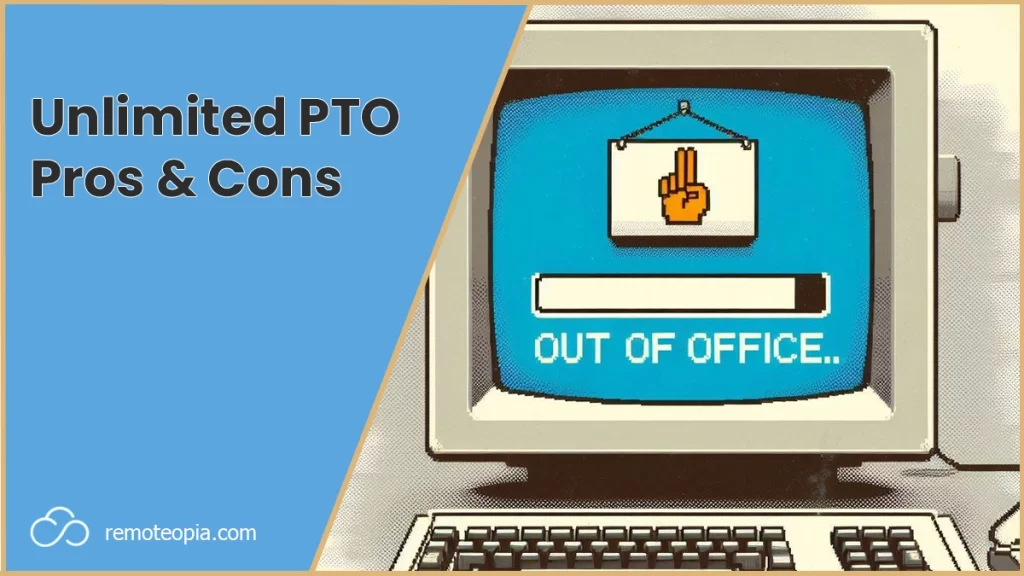
Unlimited PTO, or paid time off, has become a frequently discussed concept in modern work. The merits and pitfalls mean that it’s often deliberated, but less often implemented.
With this policy, employees are expected to manage their own time responsibly. Whilst businesses have to find a balance that supports both the company’s productivity and the well-being of its employees.
Key Takeaways
What Is Unlimited PTO?
Unlimited PTO time means there’s no set limit to the number of vacation days an employee can take off. Unlimited Personal time off provides employees with the autonomy and trust to manage their own vacation time while still maintaining their job responsibilities.
How Does Unlimited PTO Work?
In practice staff are not limited to a specific number of vacation, sick, or personal days.
Communication with managers and HR departments becomes crucial to ensure work is covered during time off.
According to the latest statistics:
The Origin Of PTO
Unlimited PTO evolved as a business response to the shift in trends of employees valuing work-life balance and an increasing desire for flexibility.
With the digitalization of work, work culture has shifted to value trust whilst viewing rest and rejuvenation as vital for our overall productivity and wellbeing.
Pros & Cons Of Unlimited PTO
Unlimited PTO offers unique benefits and challenges for employees:
Pros:
- Flexibility: Staff gain control over their work-life balance, taking time off as needed without the stress of limited days.
- Well-being: It can improve mental health, as employees are less likely to experience burnout from overwork and stress.
Cons:
- Ambiguity: Without clear guidelines, the policy can cause confusion and potential underuse, as we might worry about how taking time off is perceived.
- Resentment: If some of us take more vacation than others, it can lead to feelings of unfairness and resentment.
If you had to take unlimited vacation how much would you take?

Pros & Cons For Employers
Similarly for employers there are elements to weigh up on both sides of the coin:
Pros:
- Talent Acquisition: Attractive to prospective talent, unlimited PTO can be a significant advantage in employee retention.
- HR Efficiency: Human Resources departments benefit by not having to track individual leave balances, reducing administrative tasks.
Cons:
- Productivity Concerns: Employers might worry about potential drops in productivity if employees take excessive time off.
- Management Challenges: Managers need to ensure coverage and may struggle with the additional responsibility of monitoring fair usage without explicit PTO limits.
Companies With Unlimited PTO
In recent years, there’s been a trend toward offering employees greater flexibility and fostering a work culture that values balance and autonomy.
Unlimited PTO is a prime example of this shift, aiming to attract and retain top talent by offering them the freedom to take time off on their own terms.
Tech giants like Microsoft, Zoom, Twitter, Netflix and LinkedIn have set a benchmark in providing unlimited PTO, allowing salaried employees to take as much time off as they require.
Microsoft’s transition to an unlimited PTO policy aimed to help them stay competitive in recruiting talent whilst modernizing their vacation policy.
Jobs With Unlimited PTO
Unlimited PTO is not only for in-office positions. Remote jobs with unlimited PTO are increasingly common, with companies like Zoom providing this benefit to attract candidates who value flexibility.
By offering unlimited PTO in remote roles, companies can tap into a wider talent pool and support a work culture that fosters employee engagement and satisfaction.
Managing Unlimited PTO
It’s often a good idea for employers to run trial periods to gauge how successful or not offering unlimited PTO will be.
To successfully implement unlimited PTO a number of key areas need focus:
- Clear Communication: Set explicit expectations and foster an environment of trust to mitigate ambiguity and manage the policy effectively.
- Accountability: Both employees and employers are responsible for maintaining productivity and ensuring the system is not abused.
- Guidelines: Establishing fair guidelines helps prevent potential resentment and reinforces a positive company culture.
To effectively manage unlimited paid time off, companies should establish guidelines that balance business needs and employee freedom.
This can involve setting clear expectations for PTO requests and encouraging regular breaks to ensure team collaboration and no drop in performance.
Summary
The jury’s still out as to whether unlimited PTO is the future. Whilst it can provide more flexibility and work-life balance for some. Others can end up working more as they feel guilty taking time off if they have a large workload or feel a responsibility to others.
We’re still in the beta phase, but as more feedback is collected through the adaptation of unlimited PTO through big players like Zoom and Microsoft, we’ll soon be at a stage to make a call.
I’m more of an advocate of the 4 day work week as it is less ambiguous and studies show no downturn in productivity.
Frequently Asked Questions

James Waite
Founder of Remoteopia, James has worked in remote roles for 6 years. After a stint in recruitment, he now works as a director of website strategy in tech.




